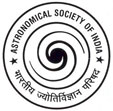February 2018:
The AstroSat Picture of the Month for February 2018 is the ultra-violet image of NGC 6960 or the Witch's Broom, using ASTROSAT. The beautiful filaments are due to gas heated up because of the shocks from the Supernova explosion that happened thousands of years ago.
(Picture Credits: Firoza K. Sutaria, K.P. Singh, P. T. Rahna, J. Murthy, A.K. Ray, N.K. Rao & A. Kumar )
To download a high resolution image, see link.


“AstroSat Picture of the Month” is an initiative of the Public Outreach and Education Committee of the Astronomical Society of India and the AstroSat Training and Outreach Team.
The Witch’s Broom
The Witch's Broom or the Western Veil, is a part of a large Supernova Remnant called the Cygnus Loop or the Veil Nebula. Extending over 3 degrees in the sky (compared to the full moon which is 0.5 degrees), and located in the northern constellation of Cygnus, the entire Cygnus Loop is 75 light years in diameter, and around 1470 light years away. Though the nebula is one of the most beautiful and colorful objects in the sky, it is quite faint due to its large angular size and a big telescope in a dark sky is needed to fully appreciate it in all its glory.
Different parts of this object were discovered separately and given different names. The Witch's Broom, or NGC 6960 is a part of this gigantic Supernova Remnant. This remnant is the result of a very massive star exploding sometime between 3000 and 6000 B.C. The shock waves of this explosion, as they blast through the surrounding gas, produce emission in all bands of light, including radio, visible, ultra-violet and X-rays. Since the expanding shells are extremely thin and is almost transparent to background optical light, only the edges are bright enough to see. This is why we see fine filaments or ropes that resemble a broom.
The Near Ultra-Violet and Far Ultra-Violet images of the Witch's Broom captured by AstroSat's UVIT show emission from these delicate glowing filaments, primarily from ionized Silicon, Carbon, Iron and Helium. Astronomers are using this data to study the chemicals in this gas, and how they are heated by the shock of the explosion.
Click here for the entire APOM archive and here to return to the latest APOM.
More about ASTROSAT
AstroSat, India's first dedicated multi-wavelength space observatory, was launched by ISRO on 28 September, 2015. It has five instruments on board – the Ultra Violet Imaging Telescope, the Soft X-ray Telescope, the Large Area X-ray Proportional Counter, the Cadmium-Zinc-Telluride Imager and the Scanning Sky Monitor.
Get answers to your common queries about ASTROSAT in English, in हिंदी, and in मराठी.

